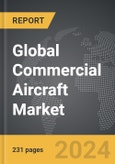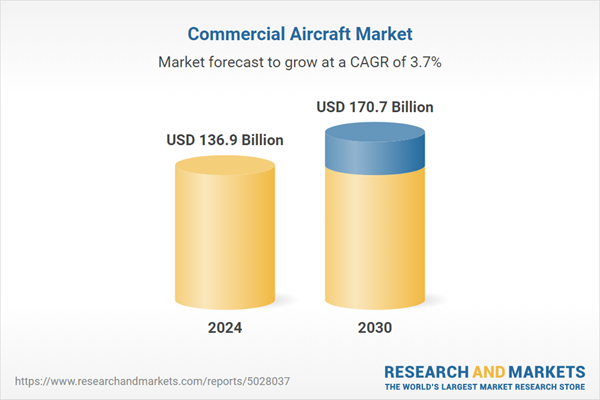The global market for Commercial Aircraft was valued at US$136.9 Billion in 2024 and is projected to reach US$170.7 Billion by 2030, growing at a CAGR of 3.7% from 2024 to 2030. This comprehensive report provides an in-depth analysis of market trends, drivers, and forecasts, helping you make informed business decisions. The report includes the most recent global tariff developments and how they impact the Commercial Aircraft market.
Segments: Aircraft Type (Narrow Body, Wide Body, Regional & Business Jet); Application (Passenger, Cargo).
Geographic Regions/Countries: World; United States; Canada; Japan; China; Europe (France; Germany; Italy; United Kingdom; Spain; Russia; and Rest of Europe); Asia-Pacific (Australia; India; South Korea; and Rest of Asia-Pacific); Latin America (Argentina; Brazil; Mexico; and Rest of Latin America); Middle East (Iran; Israel; Saudi Arabia; United Arab Emirates; and Rest of Middle East); and Africa.
The analysts continuously track trade developments worldwide, drawing insights from leading global economists and over 200 industry and policy institutions, including think tanks, trade organizations, and national economic advisory bodies. This intelligence is integrated into forecasting models to provide timely, data-driven analysis of emerging risks and opportunities.
Global Commercial Aircraft Market - Key Trends and Drivers Summarized
What Are Commercial Aircraft and Why Are They Essential to Global Connectivity?
Commercial aircraft are the backbone of global transportation networks, enabling the movement of millions of passengers and tons of cargo across vast distances every day. These aircraft are designed specifically for carrying passengers or cargo on scheduled air routes, ranging from small regional jets to massive wide-body planes capable of long-haul international flights. They are critical to the functioning of the global economy, facilitating international trade, tourism, and business travel, thereby fostering economic growth and cultural exchange. Since the inception of commercial aviation in the early 20th century, aircraft technology has continuously evolved, focusing on improving safety, fuel efficiency, and passenger comfort. Modern commercial aircraft are marvels of engineering, integrating advanced aerodynamics, lightweight composite materials, and highly efficient engines to meet the increasing demands of airlines and passengers. As the global economy becomes more interconnected, the reliance on commercial aircraft has surged, with airlines expanding their fleets to meet growing passenger numbers and serve emerging markets. Today, commercial aircraft represent one of the most critical components of global transportation infrastructure, underpinning everything from global supply chains to international tourism.How Do Technological Advances Shape the Future of Commercial Aircraft?
The evolution of commercial aircraft has been profoundly influenced by technological advancements, with each generation of planes being more efficient, reliable, and eco-friendly than its predecessors. One of the most significant technological trends is the shift towards more fuel-efficient engines and the use of lightweight materials such as carbon fiber composites, which reduce aircraft weight and, consequently, fuel consumption. The rise of electric and hybrid-electric propulsion systems is also poised to revolutionize the industry, promising a greener future for aviation by reducing carbon emissions. Alongside propulsion innovations, avionics technology has seen significant improvements, with modern aircraft featuring highly automated cockpit systems that assist pilots in navigation, communication, and even some elements of decision-making. Enhanced avionics systems, coupled with advancements in artificial intelligence, are bringing the aviation industry closer to the reality of autonomous or semi-autonomous commercial flights. Additionally, manufacturers are increasingly incorporating technologies such as 3D printing to produce aircraft components more efficiently, reducing production costs and time. Advances in aerodynamics, such as the use of blended wing body designs, also aim to improve fuel efficiency and overall aircraft performance. These technological innovations are crucial in meeting the demands of airlines and passengers for safer, more cost-effective, and environmentally sustainable air travel.What Challenges Do Commercial Aircraft Manufacturers Face in a Changing Global Market?
Commercial aircraft manufacturers operate in a highly competitive and dynamic global market, facing challenges that range from economic volatility to stringent regulatory requirements. One of the biggest challenges is the rising pressure to reduce the environmental impact of air travel, with governments and regulatory bodies implementing stricter emissions standards. The aviation industry is responsible for a significant portion of global greenhouse gas emissions, and as such, manufacturers are being pushed to develop cleaner, more fuel-efficient aircraft. In response, leading manufacturers like Boeing and Airbus have ramped up investments in research and development to produce next-generation aircraft that meet these stricter environmental guidelines while also maintaining profitability for airlines. Another significant challenge is the cyclical nature of the aviation industry, which is highly sensitive to economic downturns and external shocks, such as the COVID-19 pandemic. The pandemic led to a massive reduction in air travel demand, causing airlines to defer or cancel orders for new aircraft, which in turn affected manufacturers' production schedules and revenue streams. Furthermore, supply chain disruptions and rising material costs have created additional hurdles for manufacturers, as they struggle to keep production timelines on track while balancing costs. Despite these challenges, commercial aircraft manufacturers are continually innovating to stay competitive, exploring new market segments such as urban air mobility and supersonic travel.What Are the Key Growth Drivers in the Commercial Aircraft Market?
The growth in the commercial aircraft market is driven by several factors, including rising global air travel demand, technological advancements, and evolving airline business models. First and foremost, the increasing demand for air travel, particularly in emerging markets like Asia-Pacific and the Middle East, is a key growth driver. As populations grow and middle-class incomes rise, more people are flying for both business and leisure, prompting airlines to expand their fleets to accommodate this surge. Additionally, low-cost carriers (LCCs) are reshaping the aviation landscape by offering affordable travel options, which has increased the overall volume of air passengers. To keep up with this demand, airlines are placing large orders for single-aisle, fuel-efficient aircraft that can operate on both domestic and short international routes. Technological advancements are also playing a significant role in driving market growth, with newer aircraft models offering improved fuel efficiency, lower maintenance costs, and enhanced passenger comfort - factors that are particularly attractive to airlines looking to reduce operating costs and improve customer satisfaction. Moreover, the ongoing push toward sustainable aviation solutions, such as electric and hybrid propulsion systems, is gaining momentum, as airlines and manufacturers alike seek to meet environmental regulations and customer expectations for greener travel options. Lastly, the post-pandemic recovery of the aviation industry, with renewed confidence in the safety and necessity of air travel, is leading to an uptick in aircraft orders, particularly from airlines looking to modernize their fleets with newer, more efficient models. These trends collectively fuel the steady growth of the commercial aircraft market, positioning it for long-term expansion despite the challenges posed by economic uncertainties and environmental concerns.Report Scope
The report analyzes the Commercial Aircraft market, presented in terms of units. The analysis covers the key segments and geographic regions outlined below.Segments: Aircraft Type (Narrow Body, Wide Body, Regional & Business Jet); Application (Passenger, Cargo).
Geographic Regions/Countries: World; United States; Canada; Japan; China; Europe (France; Germany; Italy; United Kingdom; Spain; Russia; and Rest of Europe); Asia-Pacific (Australia; India; South Korea; and Rest of Asia-Pacific); Latin America (Argentina; Brazil; Mexico; and Rest of Latin America); Middle East (Iran; Israel; Saudi Arabia; United Arab Emirates; and Rest of Middle East); and Africa.
Key Insights:
- Market Growth: Understand the significant growth trajectory of the Narrow Body Aircraft segment, which is expected to reach US$93.2 Billion by 2030 with a CAGR of a 3.8%. The Wide Body Aircraft segment is also set to grow at 3.3% CAGR over the analysis period.
- Regional Analysis: Gain insights into the U.S. market, valued at $36.8 Billion in 2024, and China, forecasted to grow at an impressive 6.3% CAGR to reach $34.9 Billion by 2030. Discover growth trends in other key regions, including Japan, Canada, Germany, and the Asia-Pacific.
Why You Should Buy This Report:
- Detailed Market Analysis: Access a thorough analysis of the Global Commercial Aircraft Market, covering all major geographic regions and market segments.
- Competitive Insights: Get an overview of the competitive landscape, including the market presence of major players across different geographies.
- Future Trends and Drivers: Understand the key trends and drivers shaping the future of the Global Commercial Aircraft Market.
- Actionable Insights: Benefit from actionable insights that can help you identify new revenue opportunities and make strategic business decisions.
Key Questions Answered:
- How is the Global Commercial Aircraft Market expected to evolve by 2030?
- What are the main drivers and restraints affecting the market?
- Which market segments will grow the most over the forecast period?
- How will market shares for different regions and segments change by 2030?
- Who are the leading players in the market, and what are their prospects?
Report Features:
- Comprehensive Market Data: Independent analysis of annual sales and market forecasts in US$ Million from 2024 to 2030.
- In-Depth Regional Analysis: Detailed insights into key markets, including the U.S., China, Japan, Canada, Europe, Asia-Pacific, Latin America, Middle East, and Africa.
- Company Profiles: Coverage of players such as Airbus Group SE, Bombardier, Inc., Commercial Aircraft Corporation of China Ltd. (COMAC), Embraer SA, GE Aviation and more.
- Complimentary Updates: Receive free report updates for one year to keep you informed of the latest market developments.
Some of the 16 companies featured in this Commercial Aircraft market report include:
- Airbus Group SE
- Bombardier, Inc.
- Commercial Aircraft Corporation of China Ltd. (COMAC)
- Embraer SA
- GE Aviation
- Leonardo S.p.A
- Lockheed Martin Corporation
- Public Joint-Stock Company United Aircraft Corporation
- The Boeing Company
- United Technologies Corporation (UTC)
Tariff Impact Analysis: Key Insights for 2025
Global tariff negotiations across 180+ countries are reshaping supply chains, costs, and competitiveness. This report reflects the latest developments as of April 2025 and incorporates forward-looking insights into the market outlook.The analysts continuously track trade developments worldwide, drawing insights from leading global economists and over 200 industry and policy institutions, including think tanks, trade organizations, and national economic advisory bodies. This intelligence is integrated into forecasting models to provide timely, data-driven analysis of emerging risks and opportunities.
What’s Included in This Edition:
- Tariff-adjusted market forecasts by region and segment
- Analysis of cost and supply chain implications by sourcing and trade exposure
- Strategic insights into geographic shifts
Buyers receive a free July 2025 update with:
- Finalized tariff impacts and new trade agreement effects
- Updated projections reflecting global sourcing and cost shifts
- Expanded country-specific coverage across the industry
Table of Contents
I. METHODOLOGYII. EXECUTIVE SUMMARY2. FOCUS ON SELECT PLAYERSIII. MARKET ANALYSISSOUTH KOREAREST OF ASIA-PACIFICARGENTINABRAZILMEXICOREST OF LATIN AMERICAIRANISRAELSAUDI ARABIAUNITED ARAB EMIRATESREST OF MIDDLE EASTIV. COMPETITION
1. MARKET OVERVIEW
3. MARKET TRENDS & DRIVERS
4. GLOBAL MARKET PERSPECTIVE
UNITED STATES
CANADA
JAPAN
CHINA
EUROPE
FRANCE
GERMANY
ITALY
UNITED KINGDOM
SPAIN
RUSSIA
REST OF EUROPE
ASIA-PACIFIC
AUSTRALIA
INDIA
LATIN AMERICA
MIDDLE EAST
AFRICA
Companies Mentioned (Partial List)
A selection of companies mentioned in this report includes, but is not limited to:
- Airbus Group SE
- Bombardier, Inc.
- Commercial Aircraft Corporation of China Ltd. (COMAC)
- Embraer SA
- GE Aviation
- Leonardo S.p.A
- Lockheed Martin Corporation
- Public Joint-Stock Company United Aircraft Corporation
- The Boeing Company
- United Technologies Corporation (UTC)
Table Information
| Report Attribute | Details |
|---|---|
| No. of Pages | 231 |
| Published | April 2025 |
| Forecast Period | 2024 - 2030 |
| Estimated Market Value ( USD | $ 136.9 Billion |
| Forecasted Market Value ( USD | $ 170.7 Billion |
| Compound Annual Growth Rate | 3.7% |
| Regions Covered | Global |









